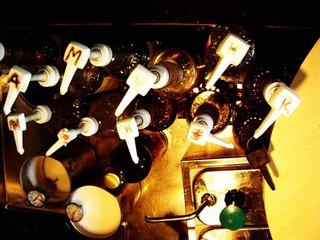Big Bucks
 Published February 01 2005
Published February 01 2005The Daily Targum
A new year begins and resolutions to try to make the world a better place are, naturally, at the top of everyone’s list.
The question arises – what can I do about the refugees in
And so the brief moment of altruistic global conscientiousness passes and we pick readily obtainable goals like losing those ten pounds of Christmas dinner that have embraced our thighs with such fervent holiday cheer.
What so many post-New Years’ dieters don't realize is that it doesn't take a lifetime of dedication to make a difference. Fair trade has slipped off the agenda in general since 2002 when aid agencies launched a massive lobby preceding the G8 summit in
Oxfam International’s “Make Trade Fair” campaign in 2002 aimed to challenge governments, international institutions and companies to change the rules governing international trade, and set free the potential of trade to reduce poverty. But Fair Trade has come to be the guise under which multinationals like Starbucks Coffee continue to exploit the developing world, while now making even more of a profit as they cater to the emerging niche of the population that actually does want to see more organic, environmentally friendly, and economically sustainable coffee for their buck.
Starbucks coffee proclaims proudly on its glossy website: coffee "is an important source of income for an estimated 25 million people living in more than 70 tropical coffee-producing countries" and, "in some cases, accounts for more than 80% of their foreign exchange earnings."
Ah the aroma of a sweet deal! We continue to indulge ourselves in a full-bodied, dark, sexy cup of liquid love, and the Nicaraguans down there in the tropics have rice on the table because of our graceful condescension through Starbucks, the middle-martyr, who “paid the farmers a fair price,” made sure “that the coffee was grown in an ecologically sound manner” and “invested something meaningful in the farming communities where our coffees are produced.”
And it's true - Starbucks has been taking more of a patronal interest in its coffee farmers, be they Nicaraguan, Ethiopian or Javanese. Starbucks, like Nike and the other mega corporate franchises that have found it impossible to continue exploiting every resource possible in order to make the bigger buck - regardless of whether these resources constituted under-aged sweat-shop laborers in Thailand or over-worked Mexican bean pickers sweating over Arabica leaves - has had to clean up its act for the sake of consumer opinion, if not out of the goodness of its heart. Any publicity is good publicity in politics, but in business, negative publicity drives down sales and generally makes bad business. The huge protests of activists and Non-Governmental Organizations such as Greenpeace, Oxfam and Amnesty International over the years have made a dent in corporate sales and forced them to change their images.
“In April 2000,” according to the Organic Consumers Association (OCA), “Starbucks became a leader among major coffee companies when it announced it would begin to offer Fair Trade coffee in thousands of stores nationwide.” It continues to lead the coffee industry as one of the largest purchasers of Fair Trade coffee, but dig a little beneath the surface and it seems that image is all that these companies aim to change.
Going legitimately ‘fair’ means losing very significant amounts of profit, and the temptation to ‘greenwash,’ or jump on the organic and social responsibility bandwagon without giving up much is strong. Out of the more than 100 million pounds of coffee that Starbucks buys each year, only 2.8 million pounds of Certified Organic coffee, 2.1 million pounds of Fair Trade certified coffee, and 1.8 million pounds of Conservation (shade-grown) coffee were bought in 2003, according to Starbucks’ latest figures. That amounts to, at most, 2.1 percent of their coffee being Fair Trade, and 6.7 of their total coffee purchases being socially responsible at some level. For a company that boldly boasts a natural and back-to-the-source image, these numbers are not representative of its image at all.
Starbucks may have been the world leader in fair trade coffee once – the “big four” coffee companies, Sara Lee, Kraft, Nestle and Proctor and Gamble having made even less of an effort to adopt Fair Trade policies with their products – but several major coffee retailers are now making significant headway in the struggle to pay fairer prices to farmers of coffee – $1.26/lb for Fair Trade coffee and $1.41/lb for organic Fair Trade coffee (which must be grown under pesticide-free and environmentally sustainable conditions) – and make enough profit to survive and grow as businesses.
Ahold
The Fair Trade seed has been sown in coffee retail, and Starbucks has been reaping the benefits of its Fair Trade and Organic image for long enough. It is time it made more of an effort to turn a green façade into tangible results. Whether it be by avoiding Starbucks for more Fair Trade- friendly brands, or demanding that the company introduce weekly Fair Trade coffees of the day instead of just once a month, the effort on your part is a small one. Here, finally, is one thing you can do.


0 Comments:
Post a Comment
<< Home